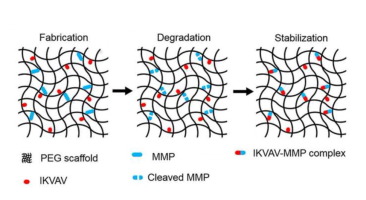Acta Biomaterialia ( IF 9.7 ) Pub Date : 2018-03-09 , DOI: 10.1016/j.actbio.2018.03.001 Hyun Ju Lim , Zara Khan , Xi Lu , T. Hiran Perera , Thomas S. Wilems , Krishna T. Ravivarapu , Laura A. Smith Callahan

|
Balancing enhancement of neurite extension against loss of matrix support in synthetic hydrogels containing proteolytically degradable and bioactive signaling peptides to optimize tissue formation is difficult. Using a systematic approach, polyethylene glycol hydrogels containing concurrent continuous concentration gradients of the laminin derived bioactive signaling peptide, Ile-Lys-Val-Ala-Val (IKVAV), and collagen derived matrix metalloprotease degradable peptide, GPQGIWGQ, were fabricated and characterized. During proteolytic degradation of the concentration gradient hydrogels, the IKVAV and IWGQ cleavage fragment from GPQGIWGQ were found to interact and stabilize the bulk Young’s Modulus of the hydrogel. Further testing of discrete samples containing GPQGIWGQ or its cleavage fragments, GPQG and IWGQ, indicates hydrophobic interactions between the peptides are not necessary for mechanical stabilization of the hydrogel, but changes in the concentration ratio between the peptides tethered in the hydrogel and salts and ions in the swelling solution can affect the stabilization. Encapsulation of human induced pluripotent derived neural stem cells did not reduce the mechanical properties of the hydrogel over a 14 day neural differentiation culture period, and IKVAV was found to maintain concentration dependent effects on neurite extension and mRNA gene expression of neural cytoskeletal markers, similar to previous studies. As a result, this work has significant implications for the analysis of biological studies in matrices, as the material and mechanical properties of the hydrogel may be unexpectedly temporally changing during culture due to interactions between peptide signaling elements, underscoring the need for greater matrix characterization during the degradation and cell culture.
Statement of Significance
Greater emulation of the native extracellular matrix is necessary for tissue formation. To achieve this, matrices are becoming more complex, often including multiple bioactive signaling elements. However, peptide signaling in polyethylene glycol matrices and amino acids interactions between peptides can affect hydrogel material and mechanical properties, but are rarely studied. The current study identifies such an interaction between laminin derived peptide, IKVAV, and collagen derived matrix metalloprotease degradable peptide, GPQGIWGQ. Previous studies using these peptides did not identify their interaction’s ability to mechanically stabilize the hydrogel during degradation. This work underscores the need for greater matrix characterization and consideration of bioactive signaling element effects temporally on the matrix’s material and mechanical properties, as they can contribute to cellular response.
中文翻译:

通过肽相互作用对蛋白水解性聚乙二醇二甲基丙烯酸酯水凝胶的机械稳定性
在含有蛋白水解可降解和生物活性信号肽的合成水凝胶中,平衡神经突延伸的增强与防止基质支持的丧失以优化组织形成是困难的。使用系统的方法,制备并表征了包含层粘连蛋白衍生的生物活性信号肽Ile-Lys-Val-Ala-Val(IKVAV)和胶原蛋白衍生的基质金属蛋白酶可降解肽GPQGIWGQ的同时连续浓度梯度的聚乙二醇水凝胶。在浓度梯度水凝胶的蛋白水解降解过程中,发现来自GPQGIWGQ的IKVAV和IWGQ裂解片段相互作用并稳定了水凝胶的整体杨氏模量。进一步测试包含GPQGIWGQ或其裂解片段GPQG和IWGQ的离散样品,表明肽之间的疏水性相互作用对于水凝胶的机械稳定化不是必需的,但是束缚在水凝胶中的肽与溶胀溶液中的盐和离子之间的浓度比变化会影响稳定性。在14天的神经分化培养期内,人诱导多能神经干细胞的封装并未降低水凝胶的机械性能,并且发现IKVAV对神经细胞骨架标记物的神经突延伸和mRNA基因表达保持浓度依赖性作用,类似于之前的学习。结果,这项工作对矩阵生物学研究的分析具有重要意义,
重要声明
天然细胞外基质的更大模拟对于组织形成是必要的。为了实现这一点,基质变得越来越复杂,通常包括多种生物活性信号元件。然而,聚乙二醇基质中的肽信号传导和肽之间的氨基酸相互作用会影响水凝胶的材料和机械性能,但很少进行研究。目前的研究确定了层粘连蛋白衍生肽IKVAV和胶原蛋白衍生基质金属蛋白酶可降解肽GPQGIWGQ之间的这种相互作用。以前使用这些肽进行的研究并未发现它们在降解过程中相互作用稳定机械稳定水凝胶的能力。



























 京公网安备 11010802027423号
京公网安备 11010802027423号